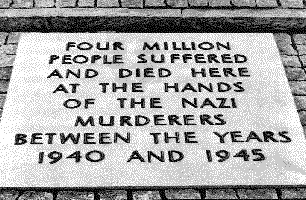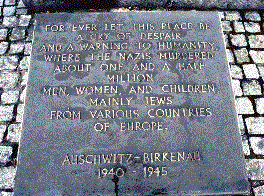The International Holocaust ControversyA Simple SubjectProf. Arthur Butz |
Plaques at Auschwitz | ||

| |||
| Before: Four Million | |||

| |||
| After: One and a half Million |
One of my dilemmas is that, by writing a whole book on the hoax, I may have suggested something that I did not wish to suggest, because there is an important point that I should perhaps have stressed. I wrote on page 24, but did not stress, the important point that –
There are many considerations supporting this view, and some are so simple that they may surprise the reader even further. The simplest valid reason for being skeptical about the extermination claim is also the simplest conceivable reason: at the end of the war, they were still there.
The dilemma I am delineating is that, by generating much verbiage on this subject, I may give some the impression that it is a complex one. Therefore let me state emphatically that the great verbiage is required not because the subject is complicated but because public opinion has become distorted by the media’s generation of many times that verbiage, generated over several decades, with the consequence that unusual and elaborate therapy is required. However, it is very important that this select group not lose sight of the fact that the subject is quite simple and that only a cultural illness has made the great efforts of revisionists necessary.
The elements in an effective expose of the hoax are not many. The principal points are as follows:
1. The Jews were singled out for special persecution by Nazi Germany. Many were deprived of their property, conscripted for labor, or deported east during the war. The German documents do not speak of exterminations. The term “Final Solution” (Endlösung) meant the expulsion of the Jews from Europe, and the deportations to the east were a step toward that objective.
2. Documents published by the International Red Cross and the Vatican do not harmonize with the extermination claims, and the very well informed wartime Pope, Pius XII, is often castigated for not speaking up against exterminations of Jews.
3. Partially on account of general wartime conditions and partially as a consequence of the German measures against the Jews (e.g. crowding into ghettos), a large number of Jews perished, but nothing near six million.
4. Published population statistics are quite meaningless, mainly because almost all of the Jews involved in the problem were East European (e.g. two or three million Polish Jews), but also because in the USA there has been no reliable count – the census does not treat this and the concept “Jew” vas not admitted into the official records when a very large number entered the U.S. after the war. To the extent that a significant number of Jews might seem to be missing from some region they occupied before the war, they can to the best of our knowledge be accounted for in terms of the massive and well known postwar movements of Jews to the U.S., Palestine. and other lands, and also in terms of their simply remaining in the Soviet Union where the Germans had put them, according to the German documents.
5. The evidence for the extermination allegations depends crucially on trials, such as the Nuremberg trials, held before courts that were for political reasons constrained to accept the basic truth of such allegations. Thus, to many relevant defendants it seemed that the only possible defense strategy was to deny not the exterminations but only their personal responsibility for them (e.g. Ernst Kaltenbrunner or Adolf Eichmann).
6. The horrible scenes found in the German camps in 1945 were the result of the total collapse – in the context of the total collapse of German industry and transport – of all German countermeasures against diseases, mainly typhus, that had plagued all German camps throughout the war. These German countermeasures had included periodic showers of all inmates and also extensive and periodic use of insecticides, such as Zyklon B, for disinfection purposes.
7. Concentration camp inmates were an important source of labor for the hard-pressed wartime German economy, and the high death rate that prevailed in the camps throughout the war was considered “catastrophic” by the Germans (Chapter 4, p.160). As a result of the high death rate, about 350,000 or perhaps 400,000 inmates died in the German camps during the war, some minority of that number being Jews.
8. There were crematoria in all of the camps for the disposal of the bodies of people who died there.
9. The camps in Germany are not even claimed to have been “extermination camps,” except in occasional publications of a frankly sensationalistic nature. The so-called “extermination camps,” such as Auschwitz, were all in Poland and were captured by the Soviet troops after having been evacuated in an orderly fashion by the Germans. The Russians found no horrible scenes comparable to those we later found in Germany and no evidence of exterminations.
10.The “gas chambers” are fictitious, and the best the bearers of the legend can do to argue their existence is to advance the ludicrous claim that the Zyklon did double duty in exterminating Jews as well as lice or to misrepresent a shower or even an ordinary room as a “gas chamber.” Another tactic is to confuse the concept of a “gas oven.” All crematorium ovens are “gas ovens.”
That is the basic structure of the hoax.
Presented orally at the 1979 conference of the Institute for Historical Review. This is a slightly edited version of the paper as published in the Journal of Historical Review, vol. 1, no. 1, Spring 1980, pp. 5-22. Reproduced from Supplement 1: The International Holocaust Controversy in Arthur R. Butz, The Hoax of the Twentieth Century, Castle Hill Publishers, 2003, first published by Historical Review Press, 1976.